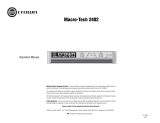
Operation Manual
Macro-Tech MA-3600VZ Power Amplifier
page 14
NOTE: For detailed information about
these Crown amplifier features, please
consult the Crown Amplifier Application
Guide, available on the Crown website
at www.crownaudio.com
5.1 Protection Systems
Your Crown amplifier provides extensive pro-
tection and diagnostic capabilities, including
ODEP and IOC.
5.1.1 Output Device Emulation
Protection (ODEP)
Crown invented ODEP to solve two long stand-
ing problems in amplifier design: To prevent
amplifier shutdown during demanding opera-
tion and to increase the efficiency of output cir-
cuitry.
To do this, Crown established a rigorous pro-
gram to measure the safe operating area (SOA)
of each output transistor before installing it in
an amplifier. Crown also designed intelligent
circuitry to simulate the instantaneous operat-
ing conditions of those output transistors. Its
name describes what it does: Output Device
Emulation Protection or ODEP. It not only simu-
lates the operation of the output transistors but
it also compares their operation to their known
SOA. If ODEP sees that more power is about to
be asked of the output devices than they are
capable of delivering under the present condi-
tions, ODEP immediately limits the drive level
until it falls within the SOA. Limiting is propor-
tional and kept to an absolute minimum—only
what is required to prevent the possibility of
output transistor damage.
This level of protection enables Crown to
increase output transistor utilization while
greatly increasing amplifier reliability.
Finally, this onboard intelligence is monitored
in two ways. First, the front panel ODEP indica-
tors show whether the amplifier is functioning
correctly or if ODEP is limiting the drive level.
Second, ODEP data is fed to the PIP connector
at the back of the amplifier so advanced PIP
modules like the PIP-Lite can use it to make
decisions and control the amplifier.
(The PIP-Lite can be used with the Macro-Tech
3600VZ.) With ODEP you get the maximum
power with the maximum protection—the
show goes on!
5.1.2 IOC (Input Output Compara-
tor)
The IOC circuit compares the output signal of
the amplifier with the input signal. If there is
any difference other than gain, then it is consid-
ered distortion and the indicator comes on. The
LED indicator will come on whenever there is
distortion of 0.05% or more. An IOC condition
may also be sensed by an IQ PIP module
installed in PIP-compatible amplifiers.
IOC is designed to report any form of distor-
tion. IOC not only checks the waveform for dis-
tortion, but also reports input overload and
even a protective action that mutes or shuts
down an amplifier. With all of these features,
IOC monitors the entire amplifier. When the IOC
indicator is off the amplifier is definitely opera-
tional and undistorted. IOC provides an on-line
proof of performance.
5.2 Circuit Designs
5.2.1 Grounded Bridge
Grounded Bridge is the name of Crown's
unique four-quadrant amplifier topology. The
Grounded Bridge topology takes full advantage
of the power supplies delivering peak-to-peak
voltages to the load that are twice the voltage
seen by the output devices and twice the volt-
age generated by the power supplies.
The power supply bridge rectifier is not ground
referenced, and the transformer secondary is
not center-tapped. This allows the power sup-
ply to deliver +VCC and -VCC from the same
bridge rectifier and filter as a total difference in
potential regardless of their voltages with
respect to ground.
Composite output devices are arranged to func-
tion as gigantic NPN and PNP devices. Each
output stage has two composite NPN and two
composite PNP devices. The devices con-
nected to the load are referred to as “high-side
NPN and PNP” and the devices connected to
ground are referred to as “low-side NPN and
PNP.” Positive current is delivered to the load
by increasing conductance simultaneously in
the high-side NPN and low-side PNP stage,
while decreasing conductance of the high-side
PNP and low-side NPN in synchrony.
Crown's Grounded Bridge design delivers large
voltage swings without stressing output tran-
sistors. The results are higher efficiency, lower
distortion and superior reliablility.
5.2.2 Variable Impedance (VZ)
VZ is the name of Crown's patented articulated
power supply technology. This innovative tech-
nology permits us to pack large amounts of
power into a compact package while achieving
ultra-low distortion and without generating
excessive heat.
An amplifier power supply must be large
enough to handle both the maximum voltage
and maximum current necesary for the ampli-
fier to drive its rated power into a specified
load. In order to meet this requirement, most
conventional supplies are heavy, large, and
produce lots of heat. In contrast, the VZ supply
gets more current AND voltage out of a smaller,
lighter, and more efficient package by dynami-
cally adapting to both signal and load require-
ments in real-time. This provides the best
power match to the widest range of loads.
The VZ supply is divided into two segments.
When the output stage requires high-voltage,
the segments are arranged in series to deliver
twice the voltage of a single segment. When the
output stage requires high-current, the seg-
ments are arranged in parallel to deliver twice
the current of a single segment. Sensing cir-
cuitry "watches" the voltage of the signal to
determine when to switch VZ modes. The
switching circuitry is designed to prevent audi-
ble switching distortion to yield the highest
possible dynamic transfer function—you hear
only the music and not the amplifier.
With VZ, you get not only maximum power and
safety, but you also get the best power match-
ing to your load.
5 Advanced Features
and Options





























